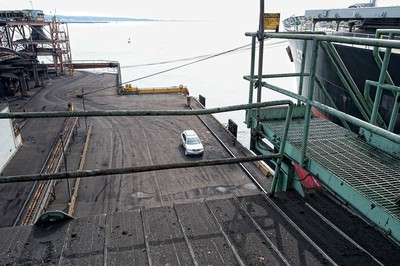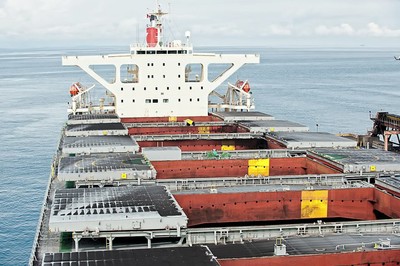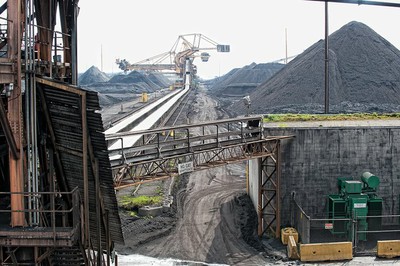Bellingham photographer Paul K. Anderson recently traveled to the Westshore Terminal in British Columbia to document what a coal export facility looks like. His images are an arresting preview of what could be in store for Longview, Bellingham, and other communities.
Bigger version here. (Copyright Paul K. Anderson, Chuckanut Conservancy. Used with permission.)
The photos below provide a good sense for just how dirty these facilities are.
The coal dust is virtually impossible to contain. Even on a calm day, it blackens the roads, equipment, and ships, and it spreads onto the water.
Bigger version here. (Copyright Paul K. Anderson, Chuckanut Conservancy. Used with permission.)
Bigger version here. (Copyright Paul K. Anderson, Chuckanut Conservancy. Used with permission.)
Bigger version here. (Copyright Paul K. Anderson, Chuckanut Conservancy. Used with permission.)
The Westshore Terminal ships roughly 24 million tons of coal each year. The facility proposed for Cherry Point, near Bellingham, would initially ship the same amount, but could easily be expanded to twice that capacity. The facility planned for the Columbia River at Longview could ship 60 million tons or more per year.












Kamala
You can see it on Google maps here:http://maps.google.com/maps?hl=en=UTF8=westshore+terminal,+british+columbia=1=westshore+terminal,=British+Columbia,+Canada=0,0,2905917259342256252=49.018466,-123.162725=0.01092,0.018969=h=16=A
Paul K. Anderson
A very unique and fascinating experience, my gracious hosts gave me unfettered access to photograph anything. Part road warrioresque, part surreal landscape. Even after 40 years of existence, dust is still their #1 issue. I do not want this in my backyard.
JNewcomb
No doubt that there are environmental challenges for coal terminals. Westshore does have extensive coal dust mitigation measures, but according to Paul Anderson, these are not sufficient (http://www.westshore.com/emanage.html). The Terminal is only 5 kms from Point Roberts, as close to some Washington residents now as a future terminal in Bellingham might be?
Hue Beattie
Some underwater photos would be interesting.Would there be any eelgrass-herring left?
Don
Come on you guys! This thing was built in the 1970s and could not possibly resemble what might be developed at Cherry Point. Rather than fear-mongering, how about trying to find out what’s actually being proposed!
Clark Williams-Derry
Kamala – I couldn’t get that link to work. Is this it, more or less?http://goo.gl/maps/innk
Eric de Place
Don,I wholeheartedly disagree. The burden of proof rests squarely on the coal companies.But I’ll make you a deal. If Peabody Coal or Carrix are operating a squeaky clean coastal coal terminal anywhere in the world, I would be very interested to hear about it! And if they provide access to an independent photographer to document it, I’ll even post the photos here. I won’t hold my breath. Coal terminals are nasty no matter where you look: Mobile, AL; Seward, AK; Virginia; Australia; South Africa… they’re a nuisance at best and a serious ecological hazard more often.
Ferndale Homeowner
How can we justify this when the chinese are working on their own coal transportation system and they don’t need ours anymore? What then?
Bear
the economy will have little to no bearing at all…it wont matter if coal and fuel continue to destroy our planet…this market will not employ even 5% of unemployed americans…despite what house of representatives voted, climate change is happening, and is caused and only increased by filthy, carbon-releasing industries as these…
Kay Porter
How many coal trains are going through Bellingham every day now? I live quite near the train tracks but can’t see the trains from my house, they are over the bank and down near the water. The train traffic has been much more frequent and noisy for some time now and I wonder if that is when the coal trains started coming that go to Canada to be shipped to China. No one asked us if we wanted those coal trains. They certainly affect those of us living near the tracks. I have asthma and these coal trains going to Canada really concern me.
Kay Porter
June 16, 2011
Phil Humphries
The bigger version photos don’t look any bigger to me. Can’t see much detail.
Mike Taylor
Coal and rail and terminals actually employ a huge number of well paid folks. We’ve been exporting eastern coal to Europe on a large scale for decades. Western coal has been exported as well though the demand is now growing exponentially.
Of course a coal terminal isn’t pretty; it’s an industrial site for crying out load. Not much different from a rock quarry or copper mine or gold mine or steel mill, or …. Sorry, but the world can’t run on 100% bucolic travel photos. Don’t want it (or the local mall) visible from your house? – If possible, I’m sure they would be glad to block it from easy view.
Dust is an issue though probably less in the Pacific NW than other places, rain being what it is up there. Can’t imagine what mold in that humid environment would do to an asthmatic. A lot more than the coal trains, I’m guessing. It seems to me the real problem with coal is that it’s black and you can’t play in it the way you would sand – never mind that quartzite is a serious carcenogin. Fact is modern coal handling is safe and today coal can be burned cleanly, regardless how easily it is maligned by and for the uniformed.
Eric de Place
Mike,
The facts are these: coal exports are among the very worst job-creating investments a port can make. Their lousy employment performance has been documented again and again, and I’ve summarized the findings here: http://www.sightline.org/2011/09/14/an-alternative-to-coal/.
You may also be interested to learn that the NW has two distinct climate zones: an arid east side that can be extremely windy in places like the Columbia Gorge where coal trains will run; and a temperate westside that experiences what is functionally a 3 month drought every summer. The Cherry Point site is particularly exposed to winds, and there is good reason to believe that coal dust would disperse just as it does from the two British Columbia coal ports farther up the coast, Westshore and Ridley.
For more research on coal dust at export terminals, see:
http://www.sightline.org/2011/03/15/are-coal-export-terminals-good-neighbors/
For more at Ridley, in particular, see:
http://www.sightline.org/2011/10/04/how-real-is-the-threat-of-coal-dust/
For more on coal dust from trains, see:
http://www.sightline.org/2011/08/10/at-least-the-website-is-clean/
Finally, coal cannot be burned cleanly (at least not with existing technology for anything that approaches cost-effectivness). CO2 pollution from coal is the single biggest threat to the global climate. Period.